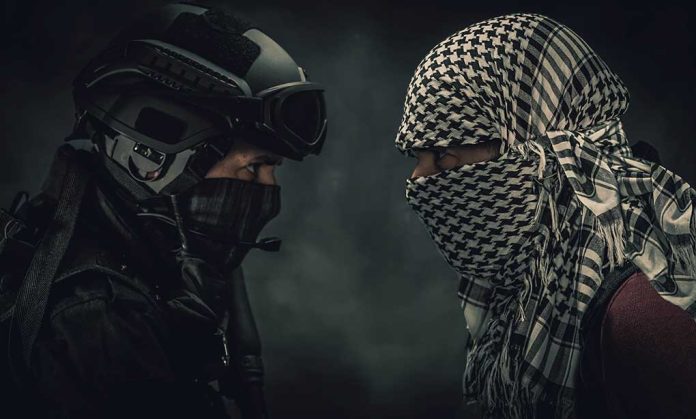
Hamas’s guerrilla warfare tactics in Gaza continue to challenge Israeli forces, despite heavy losses and widespread destruction.
At a Glance
- Hamas employs hit-and-run attacks and uses extensive tunnel networks to sustain operations
- Israel claims over 17,000 Hamas fighters killed, but the group’s tactics prevent conventional defeat
- The conflict has resulted in significant Palestinian civilian casualties and global condemnation
- Hamas aims to shift focus to Palestinian statehood and rights, planning to relinquish administrative control post-war
- Negotiations for hostage release have stalled, with approximately 133 remaining in Gaza
Hamas’s Resilient Guerrilla Tactics
The ongoing conflict in Gaza has highlighted Hamas’s adeptness at employing guerrilla warfare tactics, allowing the organization to maintain pressure on Israeli military forces despite facing heavy losses. Hamas fighters utilize ruined buildings and an extensive underground tunnel network to conduct surprise attacks and evade Israeli forces. These tactics include hit-and-run operations, booby-trapping, roadside bombs, and the use of rocket-propelled grenades.
The effectiveness of Hamas’s guerrilla strategy was underscored by a recent audacious assault that resulted in the death of Israeli Colonel Ehsan Daksa. This incident exemplifies the complex challenges Israel faces in neutralizing Hamas’s battlefield effectiveness. Despite Israel’s claims of having killed over 17,000 Hamas fighters since the war began, the group’s approach continues to frustrate Israeli forces and prevent a conventional defeat.
Impact on Israeli Military Operations
Israeli military casualties have increased as the conflict progresses, with about 260 soldiers killed and over 1,500 injured since the ground assault began. The Israeli army’s difficulty in defeating Hamas stems from the guerrilla tactics employed by the Palestinian resistance in Gaza. Military analysts and Israeli soldiers have noted the effectiveness of these strategies in prolonging the conflict.
“The guerrilla tactics employed by the Palestinian resistance in Gaza make it difficult for the Israeli army to defeat it, the New York Times reported, citing military analysts and Israeli soldiers,” according to The New York Times.
Israel has claimed significant progress in weakening Hamas’s military wing and destroying long-range rocket caches. However, the persistence of explosive devices and light arms, coupled with Hamas’s adaptive warfare strategies, continues to pose ongoing challenges for Israeli forces.
Humanitarian Concerns and International Response
The conflict has resulted in significant Palestinian civilian casualties, widespread hunger in Gaza, and deaths around relief efforts, leading to global condemnation. Human rights groups have accused Israel of using starvation as a weapon of war in Gaza, a tactic classified as a war crime under the Rome Statute of the International Criminal Court.
“Never in modern history have so many people faced starvation and famine as in Sudan today,” per the United Nations task force.
International law, including the Geneva Conventions, mandates humane treatment of civilians and proportionate use of force. The United States military’s post-9/11 experiences have emphasized the importance of minimizing collateral damage for maintaining credibility and achieving strategic success. As the conflict continues, there is increasing pressure on Israel to adhere to these principles.
Hamas’s Strategic Objectives
Despite the significant casualties and destruction in Gaza, Hamas claims a strategic victory in its conflict with Israel. The group aims to shift focus to Palestinian statehood and rights, framing its actions as a catalyst for renewed attention to the Palestinian cause. Hamas has announced plans to relinquish administrative control of Gaza post-war, advocating for a Palestinian unity government and elections.
“All the attempts by the Americans and Israelis to bypass the Palestinians and deny them their basic human rights have failed. Now we have the opportunity to set a new way forward,” said Bassem Naim.
The ongoing clash underlines a continued cycle of violence driven by Hamas’s resilient and adaptive warfare strategies, which remain an integral part of its military doctrine. As the conflict persists, the international community continues to grapple with finding a resolution that addresses the complex issues at the heart of this enduring struggle.
Sources:
- https://mwi.westpoint.edu/minimizing-collateral-damage-with-the-surgical-application-of-force-applying-lessons-from-the-post-9-11-wars-to-israels-war-against-hamas/
- https://www.palestinechronicle.com/endless-war-how-palestinian-resistances-guerrilla-tactics-frustrate-israeli-forces/
- https://www.wsj.com/world/middle-east/hamas-strategy-israel-war-0292d40c
- https://www.csmonitor.com/World/Middle-East/2024/0711/gaza-war-victory-hamas-future-palestinians
- https://www.nytimes.com/2024/04/22/us/politics/israel-gaza-hamas-war.html
- https://www.rand.org/topics/featured/israel-hamas-war.html
- https://www.nytimes.com/2024/10/22/world/middleeast/hamas-israel-gaza-guerrilla.html










